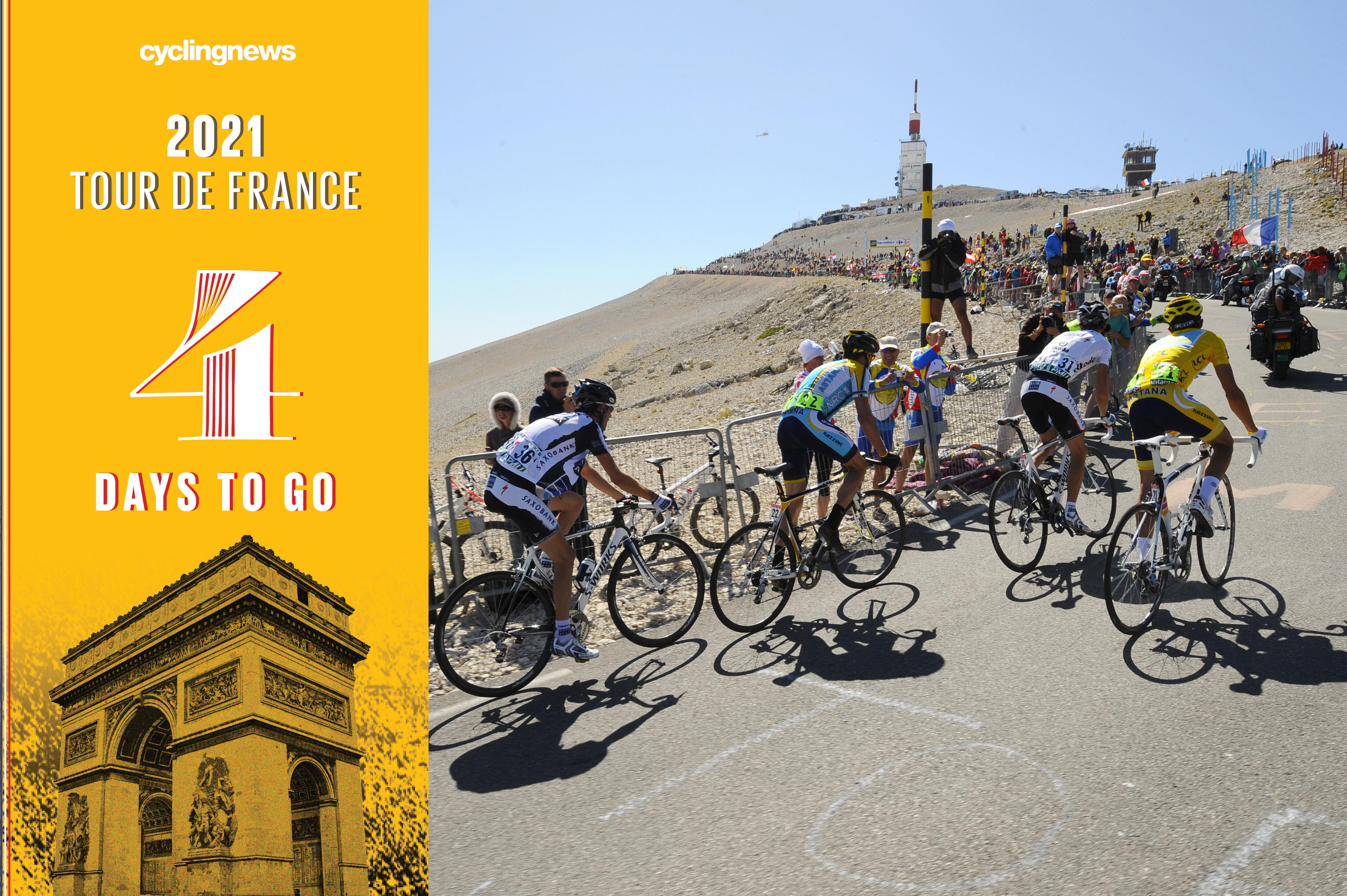The mystique of Mont Ventoux in Tour de France history
Dual ascents of the Giant of Provence to add to Tour de France history in 2021

The Tour de France has been sparing in its visits to Mont Ventoux over the past 70 years, which has undoubtedly helped to preserve the mystique of the bald mountain. In that light, the double ascent of the climb on stage 11 of this year's race feels like something of an indulgence.
Mont Ventoux first featured on the route in 1951 and the race came back just 12 months later but since then, the organisation has always seen fit to leave at least three years before returning to the mountain. Other giants like the Galibier and the Tourmalet are near perennials and are almost taken for granted. An ascent of Mont Ventoux, by its very rarity, always has the feel of a veritable occasion.
And yet the Tour's first two visits were overshadowed in posterity by events elsewhere in those races. The 1951 Tour is remembered more for Hugo Koblet's remarkable solo exploit on the road to Agen and Abdel-Kader Zaaf's dramatic abandon en route to Nîmes than for the Tour's first ascent of Mont Ventoux, by the gentler Malaucène approach.
Lucien Lazarides was first to the top then, on a stage won by Louison Bobet. Twelve months later, Jean Robic led over the top from the tougher, Bedoin approach en route to stage victory in Avignon, but that feat was a mere footnote in what was, in many respects, the first modern Tour. Mountaintop finishes featured for the first time and an unassailable Fausto Coppi claimed all three summits, winning at Alpe d'Huez, Sestriere and the Puy de Dôme.
Mont Ventoux's central place in Tour de France lore perhaps begins in 1955, when it proved pivotal to the outcome of the race and, just as importantly, when it added the race's mythmaking. In the rainbow jersey of world champion, Bobet forged clear on the upper slopes and rode 60 kilometres alone to win by six minutes in Avignon, teeing up his third straight overall victory.
The day's indelible image was captured near the summit, and shows Bobet alone against a backdrop of broken white stones, turning to scan for chasers with haunted eyes, but the day's enduring myth came midway up the ascent when 1950 Tour winner Ferdi Kubler surged clear of the leaders.
Raphael Geminiani reportedly called out, "Careful Ferdi, the Ventoux isn't a col like the others!" to which Kubler supposedly retorted: "Ferdi isn't a rider like the others!" When Geminiani next saw Kubler four kilometres later, he was weaving across the road, begging to be pushed.
The latest race content, interviews, features, reviews and expert buying guides, direct to your inbox!
He eventually reached Avignon despite being so disoriented that he rode in the wrong direction at one point, but it was effectively the end of his career. "Ferdi killed himself on the Ventoux," he said on abandoning the next day.
As ever in cycling, myth sat uneasily alongside reality. That same afternoon, French rider Jean Malléjac simply keeled over while grinding his way to the summit. As Malléjac lay on the mountainside with one foot still strapped into his pedals, he was hurriedly administered oxygen, but it took almost 15 minutes before he came around. Stimulants were the suspected cause, even if Malléjac and his soigneur denied all culpability. "He was no longer in the real world, still less in the world of cyclists and the Tour de France," Jacques Augendre wrote in L'Équipe the following day.
Cycling's failure to heed the warnings of the Malléjac episode would have tragic consequences when the Tour returned 12 years later. In the intervening period, Mont Ventoux featured twice as a summit finish, in a time trial won by Charly Gaul in 1958, and on a road stage claimed by Raymond Poulidor in 1965, but nothing marked the Tour's relationship with the mountain like Tom Simpson's death on its slopes in 1967.
Simpson had been dropped from the group of leaders when he collapsed for the first time two kilometres from the summit, but he ignored mechanic Harry Hall's attempts to convince him to stop. On remounting, Simpson managed another 200 metres or so before coming to a halt, held up by a group of spectators. By the time he was airlifted off the mountain, Simpson was already dead. Tubes of amphetamine were found in his jersey pockets.
Like so much about Mont Ventoux, fact and fiction were confused in the aftermath of Simpson's death. According to lore, his final words were the romantic "Put me back on my bike." According to Hall, Simpson's last utterance was simpler but no less sobering: "On, on, on."
Writing for La Gazzetta dello Sport, a young Gianni Mura offered a restrained but touching account of the tragedy: "It's awful to die in silence, without a breath, your eyes open without seeing."
Simpson's death opened eyes regarding the problem of doping in cycling, and drug testing was enacted at the Tour de France the following year, but it would take a long time before anyone was willing to see clearly.
Merckx and the modern era

A monument to Simpson had been erected by the time the Tour returned in 1970 when Eddy Merckx soloed to victory at the summit. The Belgian had been the lone continental professional to attend Simpson's funeral in Haworth three years earlier, and as he rode past the monument, he glanced left to see Tour director Jacques Goddet laying a wreath in tribute.
While Merckx was a dominant stage winner as he soared towards his second Tour victory, he was almost defeated by the Ventoux itself. Already betraying rare signs of suffering in the final kilometres, Merckx found himself being administered oxygen in an ambulance after the finish. "No, it's impossible," he had gasped on crossing the line.
That Merckx could be so humbled by the Ventoux – even in victory – only heightened the otherness of the mountain in Tour lore. It is neither the highest, steepest nor longest climb the race has tackled, but the heat of a Provencal July and the high winds that regularly buffet the six kilometres after Chalet Reynard make it a unique test.
Bernard Thévenet overcame it two years later, while Gonzalo Aja led over the summit in 1974, but some 13 years would pass before the ascent returned to the Tour. An entire generation had come and gone without sampling the Giant of Provence in the white heat of July, even if it occasionally featured in Paris-Nice in March in the interim.
At the 1987 Tour de France, Jean-François Bernard looked to have tamed the Ventoux when he thrashed his way into the yellow jersey in the mountain time trial to the top, but he would pay for those exertions in the final week, dropping to third overall. The mountain can move in mysterious ways.
The Tour's next visit seven years later marked the last time Mont Ventoux featured on the route without being a summit finish. Marco Pantani had emerged as a new force in the summer of 1994 and he again illuminated proceedings on Mont Ventoux, but his aggression came too late. Eros Poli had built up a lead of 20 minutes in a lone break before the climb, and despite shipping a minute per kilometre towards the top, he hauled his 6 foot-5 frame over the summit in front and held on to win the stage in Carpentras.
Pantani claimed the summit for himself when the Tour de France returned in 2000, though it was a muted kind of glory. After tempering Pantani's defiance in the finale, Lance Armstrong granted victory to his rival at the line, only for the Italian to take umbrage at the gesture.
That would be as good as it got on the Giant of Provence for Armstrong, who was second again in 2002. "That mountain doesn't like me," he once complained, and Mont Ventoux was indeed one of the few things that refused to bend to Armstrong's will during those years of excess. A decade later, he would be excised from the record books altogether.
In 2009, Mont Ventoux featured on the final weekend, a break with the Tour's long-standing tendency of bookending the race with a flat time trial. The anticipated pyrotechnics didn't quite materialise, however. Juan Manuel Garate won the stage, while Alberto Contador controlled Andy Schleck to seal the overall victory.
The Tour's last two visits were rather more memorable. In 2013, Chris Froome soloed to victory by simply burning Alberto Contador off his wheel with disarming ease and then found himself defending the performance in his rest day press conference the following morning. "To compare me with Lance… Lance cheated, I'm not cheating. End of story," said Froome.
The Briton was at the centre of attention in 2016, too, when high winds meant the finish line was placed at Chalet Reynard rather than at the summit. Thomas De Gendt won the stage, but the drama came further down the mountain, when Froome, Richie Porte and Bauke Mollema crashed into the back of a television motorbike that had been forced to a sudden halt.
Froome, his bike broken, briefly attempted to run up the climb before receiving a replacement machine. He initially lost two minutes and the yellow jersey, only for the commissaires to correct his time and keep him in the overall lead. The debate over the whys and wherefores of that decision was heated but short-lived, rendered inconsequential by the terrorist atrocity in Nice that same Bastille Day evening.
Five years on, the Tour returns to Mont Ventoux on July 7, and in an edition curiously light on climbing, the twin ascent of the famous old mountain takes on increased significance. Like the Mont Ventoux Dénivelé Challenge, the stage takes in two different ascents of the Giant, first ascending from Sault (22km at 5.1%) and then circling around for a second ascent by way of the classic approach from Bedoin (15.7km at 8.8%).
For the first time since 1994, the finish will not be on the mountain itself, but over the other side, with the race descending 22km to the line in Malaucène. The day will be defined, however, by what happens on the upper reaches of Mont Ventoux.
In the dog days of July, when the sun beats down on Provence, the bald peak shimmers on the horizon like a mirage. And when the Tour ascends towards the lonesome observatory at the top, the line between myth and reality is often blurred. Another instalment awaits.

Barry Ryan was Head of Features at Cyclingnews. He has covered professional cycling since 2010, reporting from the Tour de France, Giro d’Italia and events from Argentina to Japan. His writing has appeared in The Independent, Procycling and Cycling Plus. He is the author of The Ascent: Sean Kelly, Stephen Roche and the Rise of Irish Cycling’s Golden Generation, published by Gill Books.